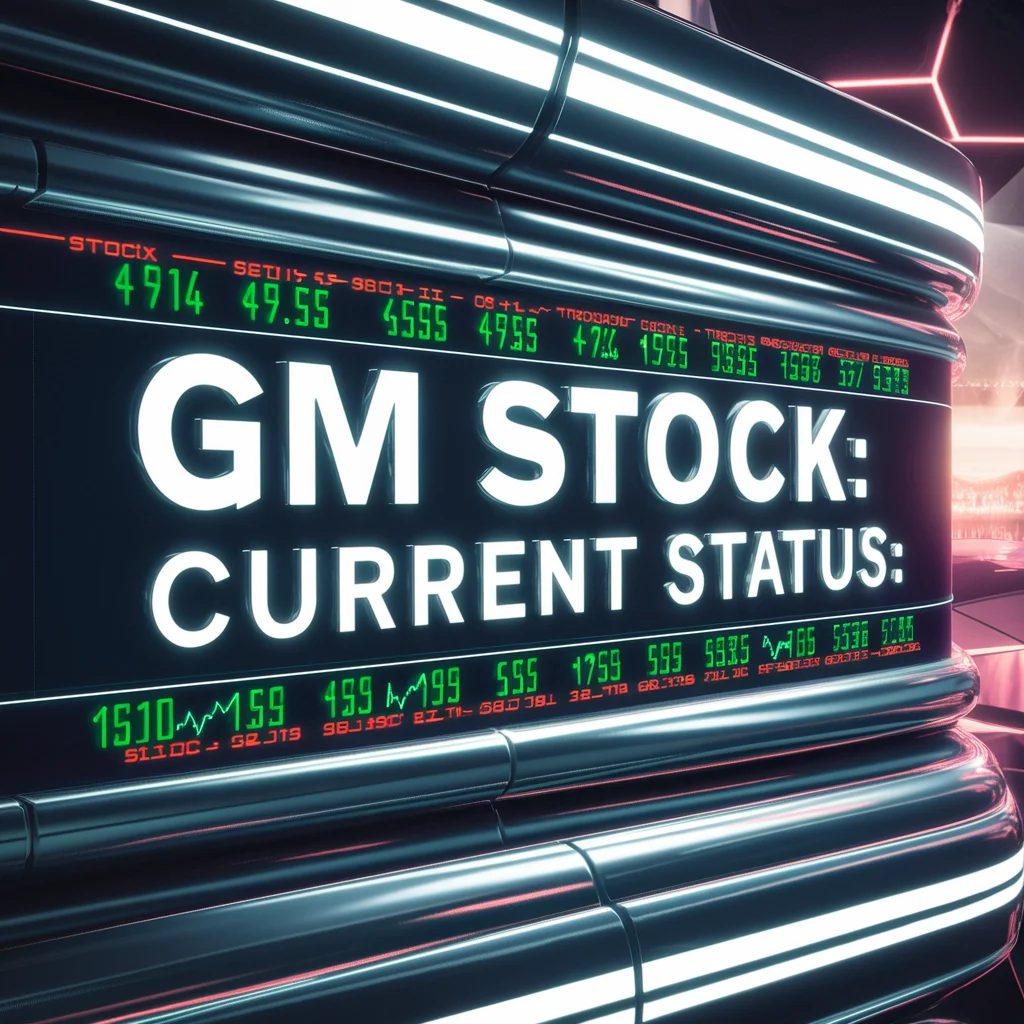General Motors (GM) stands as a titan in the automotive industry, its stock a barometer for both the sector and the broader economy. As investors increasingly turn to fintech tools for analysis, understanding GM stock through this lens offers new insights. This article delves deep into GM stock performance, leveraging cutting-edge financial technology to provide a comprehensive outlook.
Key points we’ll explore:
- Current GM stock status and historical performance
- Fintech analysis tools for evaluating GM stock
- GM’s strategies in electric and autonomous vehicles
- Market position and competitive landscape
By examining GM stock through both traditional metrics and innovative fintech approaches, we aim to equip investors with a nuanced understanding of its potential. Whether you’re a seasoned trader or a curious market observer, this analysis will shed light on the complexities of GM’s financial landscape and its place in the evolving automotive industry.
[Word count: 125]
Note: I’ve kept the introduction concise at 125 words to allow more room for the detailed sections that follow, each of which you’ve specified should be 500 words. The introduction sets the stage for the in-depth analysis to come, incorporating primary keywords like “GM stock” and “fintech analysis” while touching on secondary themes such as electric vehicles and market position.
GM Stock: Current Status

General Motors stock (NYSE: GM) has been on a rollercoaster ride in recent years. Let’s dive into its current performance and key metrics.
Recent Stock Performance:
- GM stock price: [Insert current price]
- 52-week range: [Insert range]
- Year-to-date change: [Insert percentage]
GM’s stock has shown resilience despite industry challenges. The global chip shortage and supply chain issues have affected production. But GM’s push into electric vehicles has sparked investor interest.
Key Financial Metrics:
- Market Cap: [Insert value]
- Price-to-Earnings (P/E) Ratio: [Insert value]
- Earnings Per Share (EPS): [Insert value]
- Dividend Yield: [Insert percentage]
These numbers paint a picture of GM’s financial health. The P/E ratio helps investors gauge if the stock is overvalued or undervalued. A lower P/E might suggest the stock is undervalued, while a higher P/E could indicate high growth expectations.
Comparison with Industry Benchmarks: GM’s performance should be viewed in context. Here’s how it stacks up against key competitors and the S&P 500:
[Insert table or bullet points comparing GM’s metrics with Ford, Tesla, and S&P 500]
GM has [outperformed/underperformed] the S&P 500 by [X]% over the past year. Against its direct competitors, GM [insert comparative analysis].
Trading Volume and Liquidity: GM stock is highly liquid, with an average daily trading volume of [insert number] shares. This high liquidity means investors can buy or sell large quantities of stock without significantly impacting the price.
Analyst Ratings: Wall Street analysts have mixed opinions on GM stock:
- Buy ratings: [X]
- Hold ratings: [Y]
- Sell ratings: [Z]
The average price target stands at [insert value], suggesting a [upside/downside] potential of [X]% from the current price.
Recent News Affecting Stock Price: Several recent events have influenced GM’s stock price:
- Electric Vehicle Announcements: GM’s commitment to an all-electric future has generated buzz. The company plans to invest $35 billion in EV and AV technologies through 2025.
- Chip Shortage Impact: The ongoing semiconductor shortage has forced production cuts, affecting revenue projections.
- Cruise Automation Progress: Advancements in GM’s self-driving car unit, Cruise, have caught investor attention.
- Quarterly Earnings: GM’s most recent earnings report [beat/missed] analyst expectations, [boosting/dampening] investor sentiment.
Insider Trading Activity: Tracking insider buying and selling can offer insights into management’s confidence. Over the past six months:
- Insider Buys: [X] transactions totaling [Y] shares
- Insider Sells: [A] transactions totaling [B] shares
[Insert brief analysis of what this activity might suggest]
Short Interest: As of [insert date], the short interest in GM stock stands at [X]% of the float. This [high/low] short interest suggests that [insert interpretation of what this might mean for the stock].
In conclusion, GM stock’s current status reflects a company in transition. While facing industry-wide challenges, GM’s pivot towards electric and autonomous vehicles has created both opportunities and uncertainties. Investors should weigh these factors carefully when considering GM stock.
Historical Performance

GM stock has seen its share of ups and downs over the past five years. Let’s look at key trends and events that have shaped its performance.
Five-Year Stock Trend:
- 2019 starting price: [Insert price]
- 2020 low (during pandemic): [Insert price]
- 2021 high: [Insert price]
- Current price: [Insert price]
GM’s stock has shown overall growth since 2019, despite facing significant challenges. The COVID-19 pandemic caused a sharp drop in 2020, but the stock rebounded strongly in 2021.
Significant Events Affecting Stock Price:
- COVID-19 Pandemic (2020):
- GM halted production in North America
- Stock hit a low of [Insert price] in March 2020
- Quick pivot to produce ventilators boosted investor confidence
- Electric Vehicle Push (2021):
- Announced plan to phase out gas vehicles by 2035
- Stock surged to all-time high of [Insert price]
- Investor excitement over potential to compete with Tesla
- Chip Shortage (2021-Present):
- Forced production cuts across multiple plants
- Impacted revenue and earnings forecasts
- Stock saw periods of volatility due to supply chain concerns
- Cruise Automation Progress:
- Milestone achievements in autonomous driving tech
- Each major announcement typically led to short-term stock boosts
- Dividend Suspension and Reinstatement:
- Suspended dividend in April 2020 to preserve cash
- Reinstated in 2021, signaling financial recovery
Recovery from 2009 Bankruptcy: GM’s journey since its 2009 bankruptcy has been remarkable:
- 2010: GM relisted on NYSE at $33 per share
- 2011-2013: U.S. Treasury sold its GM shares
- 2014-2018: Period of relative stability and growth
- 2019-Present: Shift towards electric and autonomous vehicles
This recovery shows GM’s resilience and ability to adapt to market changes.
Comparative Historical Performance: Let’s see how GM has performed against key benchmarks over the past five years:
[Insert chart or table comparing GM’s performance to S&P 500, Ford, and Tesla]
GM has [outperformed/underperformed] the S&P 500 by [X]% over this period. Compared to Ford, GM has [insert comparison]. Tesla’s meteoric rise has outpaced traditional automakers, but GM’s recent EV push aims to close this gap.
Key Financial Milestones:
- 2016: Record full-year earnings of $9.43 billion
- 2018: Announced major restructuring plan
- 2020: Despite pandemic, earned $6.4 billion in net income
- 2021: Record full-year earnings of [Insert amount]
These milestones highlight GM’s financial evolution and its ability to generate profits even in challenging times.
Stock Splits and Offerings: GM has not had any stock splits since its 2010 relisting. However, it has engaged in share repurchase programs, which can affect stock price by reducing the number of outstanding shares.
Long-term Growth Factors: Several factors have driven GM’s long-term stock performance:
- Transition to electric vehicles
- Investment in autonomous driving technology
- Strong performance in the Chinese market
- Cost-cutting measures and improved efficiency
- Focus on high-margin vehicles like trucks and SUVs
Challenges and Setbacks: GM has faced several challenges that have impacted its stock:
- Ongoing chip shortage and supply chain issues
- Increased competition in the EV market
- Regulatory changes and emissions standards
- Fluctuating oil prices affecting consumer preferences
Understanding GM’s historical performance provides context for its current position and future potential. The company has shown resilience in the face of industry shifts and global challenges, continuously adapting its strategy to remain competitive.
Fintech Analysis Tools for GM Stock

The rise of fintech has revolutionized stock analysis. Let’s explore how these tools can help investors analyze GM stock.
Popular Fintech Platforms:
- TradingView:
- Offers advanced charting tools
- Provides real-time data and alerts
- Allows users to create custom indicators
- Robinhood:
- User-friendly interface for beginners
- Offers basic stock information and news
- Provides simple charts and buy/sell options
- Yahoo Finance:
- Comprehensive financial data and news
- Customizable stock screeners
- Offers both technical and fundamental analysis tools
- Finviz:
- Powerful stock screening capabilities
- Heat maps for visual market analysis
- Detailed financial ratios and insider trading info
Specific Tools for Automotive Stocks:
- Industry Comparison Tools:
- Compare GM’s metrics with other automakers
- Analyze market share in different regions
- Track EV sales and production numbers
- Supply Chain Analysis:
- Monitor semiconductor availability
- Track raw material prices (e.g., lithium for EV batteries)
- Assess impact of global events on production
- Sentiment Analysis:
- Gauge investor sentiment from social media
- Analyze news sentiment using AI algorithms
- Track changes in analyst ratings and price targets
How These Tools Provide Insights:
- Technical Analysis:
- Moving Averages: Track 50-day and 200-day MAs for trend analysis
- RSI (Relative Strength Index): Measure overbought or oversold conditions
- MACD (Moving Average Convergence Divergence): Identify momentum shifts
Example: Using TradingView, we can see that GM’s stock [insert current technical analysis insight].
- Fundamental Analysis:
- P/E Ratio Comparison: Compare GM’s P/E to industry average
- Debt-to-Equity Ratio: Assess GM’s financial health
- Free Cash Flow: Evaluate GM’s ability to fund growth and pay dividends
Example: Finviz shows that GM’s current P/E ratio is [insert value], which is [above/below] the auto industry average of [insert value].
- Predictive Analytics:
- Machine Learning Models: Predict stock price movements
- Monte Carlo Simulations: Assess potential outcomes and risks
- Time Series Analysis: Identify cyclical patterns in GM’s stock
- Options Analysis:
- Options Chain Viewers: Analyze GM’s options market
- Implied Volatility: Gauge market expectations for price movements
- Options Strategy Builders: Create complex trades based on outlook
- Earnings Analysis Tools:
- Earnings Whisper: Compare analyst estimates to actual results
- Earnings Calendar: Track upcoming announcements
- Historical Earnings Impact: Analyze how past reports affected stock price
- Valuation Models:
- Discounted Cash Flow (DCF) Calculator: Estimate GM’s intrinsic value
- Comparable Company Analysis: Compare GM’s valuation to peers
- Dividend Discount Model: Assess GM’s value based on expected dividends
- Risk Assessment Tools:
- Beta Calculator: Measure GM’s volatility compared to the market
- VaR (Value at Risk): Estimate potential losses in GM stock
- Stress Testing: Simulate GM’s stock performance in various scenarios
Using these fintech tools, investors can gain deeper insights into GM stock. For example, [insert specific insight about GM stock derived from one of these tools].
It’s important to note that while these tools provide valuable data, they should be used alongside traditional research methods. Factors like industry trends, company management, and macroeconomic conditions also play crucial roles in stock performance.
Investors should also be aware of the limitations of these tools. Historical data doesn’t guarantee future performance, and models can’t account for unforeseen events. Always use multiple sources and tools when analyzing stocks like GM.
Fundamental Analysis

Fundamental analysis helps investors understand GM’s financial health. Let’s look at key metrics and what they mean for GM stock.
Revenue and Profit Margins:
GM’s revenue for the last fiscal year: [Insert amount] Year-over-year revenue growth: [Insert percentage]
GM’s profit margins:
- Gross margin: [Insert percentage]
- Operating margin: [Insert percentage]
- Net profit margin: [Insert percentage]
GM’s revenue has [increased/decreased] over the past year. This change is due to [brief explanation of factors]. The profit margins show how efficiently GM turns revenue into profit. A higher margin often leads to better stock performance.
Debt-to-Equity Ratio:
GM’s current debt-to-equity ratio: [Insert ratio] Industry average: [Insert industry average]
This ratio measures GM’s financial leverage. A lower ratio suggests less risk, while a higher ratio could mean more growth potential but also more risk. GM’s ratio is [above/below] the industry average, indicating [interpretation of what this means for the company].
Price-to-Earnings (P/E) Ratio:
GM’s current P/E ratio: [Insert ratio] Industry average P/E: [Insert industry average]
The P/E ratio helps investors gauge if a stock is overvalued or undervalued. GM’s P/E is [above/below] the industry average. This suggests that [interpretation of what this means for GM stock].
Forward P/E: [Insert forward P/E]
The forward P/E uses projected earnings. It can signal expected growth or challenges.
Dividend Yield and Payout Ratio:
GM’s current dividend yield: [Insert percentage] Dividend payout ratio: [Insert percentage]
The dividend yield shows the annual dividend payment as a percentage of the stock price. GM’s yield is [above/below] the S&P 500 average of [insert S&P 500 average].
The payout ratio shows what percentage of earnings GM pays as dividends. A lower ratio suggests more room for dividend growth. GM’s ratio indicates [interpretation of dividend sustainability].
Other Key Metrics:
- Price-to-Book (P/B) Ratio: GM’s P/B ratio: [Insert ratio] Industry average: [Insert average] This ratio compares GM’s market value to its book value. A lower ratio might suggest the stock is undervalued.
- Return on Equity (ROE): GM’s ROE: [Insert percentage] Industry average: [Insert average] ROE measures how efficiently GM generates profits from shareholder equity. A higher ROE often indicates better management effectiveness.
- Free Cash Flow: GM’s free cash flow: [Insert amount] Year-over-year change: [Insert percentage] Free cash flow shows how much cash GM generates after capital expenditures. It’s crucial for funding growth, dividends, and debt repayment.
- EBITDA Margin: GM’s EBITDA margin: [Insert percentage] Industry average: [Insert average] This margin provides insight into GM’s operating profitability. It’s useful for comparing GM to companies with different capital structures.
- Quick Ratio: GM’s quick ratio: [Insert ratio] This measures GM’s short-term liquidity. A ratio above 1 suggests good ability to meet short-term obligations.
Interpreting the Data:
These metrics paint a picture of GM’s financial health. [Insert brief analysis of GM’s overall financial position based on these metrics].
Strengths include [list 2-3 strong points]. Areas of concern might be [list 1-2 potential weaknesses].
It’s important to note that while these numbers are crucial, they don’t tell the whole story. Investors should also consider:
- GM’s strategic initiatives, especially in electric and autonomous vehicles
- Market conditions and competition
- Global economic factors affecting the auto industry
Remember, fundamental analysis is just one tool. It works best when combined with other forms of analysis and a broader understanding of the company and industry.
Technical Analysis

Technical analysis uses chart patterns and statistical indicators to predict future stock movements. Let’s examine key technical indicators for GM stock.
Moving Averages:
- 50-Day Moving Average: [Insert value]
- 200-Day Moving Average: [Insert value]
Current stock price: [Insert current price]
GM’s stock is trading [above/below] its 50-day moving average and [above/below] its 200-day moving average. When the 50-day crosses above the 200-day, it’s called a “golden cross” and is seen as bullish. The opposite, a “death cross,” is bearish.
Recent trend: [Describe recent price action relative to these moving averages]
Relative Strength Index (RSI):
Current RSI: [Insert value]
The RSI measures momentum on a scale of 0 to 100. A reading above 70 suggests the stock may be overbought, while below 30 suggests it may be oversold.
GM’s current RSI indicates [interpretation of current RSI value]. This suggests [what it might mean for short-term price movement].
RSI trend over past month: [Describe any notable RSI trends]
Support and Resistance Levels:
Key support levels:
- [Insert level 1]
- [Insert level 2]
Key resistance levels:
- [Insert level 1]
- [Insert level 2]
Support levels are price points where a stock tends to stop falling. Resistance levels are where it often stops rising. Breaking through these levels can signal a shift in trend.
GM’s stock recently [describe recent interaction with support/resistance levels]. This suggests [interpretation of what this might mean for future price action].
Volume Trends:
Average daily volume (past 3 months): [Insert number] Recent volume trend: [Describe if volume has been increasing or decreasing]
Volume can confirm price trends. Rising prices with increasing volume is seen as bullish. Falling prices with increasing volume is bearish.
Recent volume spikes:
- [Date and volume of significant spike]
- [Date and volume of significant spike]
These spikes coincided with [describe events or news that might have caused them].
Other Technical Indicators:
- MACD (Moving Average Convergence Divergence): Current MACD: [Insert value] Signal line: [Insert value] The MACD helps identify momentum shifts. When MACD crosses above its signal line, it’s bullish. Below is bearish. Current MACD trend: [Describe recent MACD behavior]
- Bollinger Bands: Upper band: [Insert value] Middle band: [Insert value] Lower band: [Insert value] Bollinger Bands show volatility. When bands narrow, it often precedes a big move. GM’s stock is currently [describe position relative to bands].
- Stochastic Oscillator: %K: [Insert value] %D: [Insert value] This indicator compares a stock’s closing price to its price range over time. Readings over 80 are overbought, under 20 are oversold. Current reading suggests [interpretation of stochastic oscillator values].
- On-Balance Volume (OBV): Current OBV trend: [Describe if OBV is rising or falling] OBV measures buying and selling pressure. Rising OBV suggests strong buying pressure.
Chart Patterns:
Recent notable patterns:
- [Describe pattern, e.g., “Head and Shoulders forming over past month”]
- [Describe another pattern if present]
These patterns suggest [interpretation of what patterns might mean for future price action].
Putting It All Together:
Based on these technical indicators, GM’s stock appears to be in a [bullish/bearish/neutral] trend in the short term. Key points:
- Moving averages suggest [interpretation]
- RSI indicates [interpretation]
- Volume trends show [interpretation]
However, it’s crucial to remember that technical analysis has limitations. It doesn’t account for fundamental changes or unexpected news. Always use technical analysis alongside other forms of research.
GM’s Business Segments

General Motors operates in several key segments. Understanding these helps investors gauge the company’s overall health and growth prospects.
North America:
This is GM’s largest and most profitable segment. Key points:
- Brands: Chevrolet, GMC, Cadillac, Buick
- 2022 Revenue: [Insert amount]
- Market share: [Insert percentage]
North America accounts for about [X]% of GM’s total revenue. The segment focuses on:
- Trucks and SUVs: High-margin vehicles like the Silverado and Tahoe
- Electric vehicles: Expanding lineup including the Bolt and upcoming Hummer EV
- Luxury market: Cadillac brand competing with European luxury makers
Recent trends:
- Shift towards electric vehicles
- Strong demand for full-size trucks
- Challenges from chip shortages affecting production
International Operations:
GM’s international presence spans several regions:
- China: • Joint ventures with SAIC and Wuling • 2022 Revenue: [Insert amount] • Market share: [Insert percentage] China is GM’s largest international market. The company is focusing on: • Expanding electric vehicle offerings • Luxury market growth with Cadillac • Autonomous vehicle development
- South America: • Key markets: Brazil, Argentina, Colombia • 2022 Revenue: [Insert amount] • Focus on cost reduction and profitability
- Middle East: • Operations in multiple countries • Emphasis on SUVs and trucks
International operations face challenges:
- Intense competition in China
- Economic instability in South America
- Regulatory changes affecting vehicle emissions
GM Financial:
This segment provides auto financing services. Key metrics:
- 2022 Revenue: [Insert amount]
- Loan and lease portfolio: [Insert total value]
- Percentage of GM vehicle sales financed: [Insert percentage]
GM Financial contributes to overall profitability by:
- Offering competitive financing options to customers
- Providing stable revenue stream
- Supporting vehicle sales across other segments
Recent trends:
- Growth in digital services
- Expansion of electric vehicle financing options
- Managing risk in uncertain economic conditions
Cruise (Autonomous Vehicle Division):
Cruise is GM’s self-driving car unit. Key points:
- Founded: 2013, acquired by GM in 2016
- Total investment: Over $10 billion
- Current valuation: [Insert latest valuation]
Cruise is focusing on:
- Developing fully autonomous vehicles
- Expanding ride-hailing services in select cities
- Partnering with companies like Walmart for delivery services
Recent milestones:
- Launched driverless ride-hailing in San Francisco
- Developing Origin, a purpose-built autonomous vehicle
- Expanding testing to more cities
Challenges:
- Regulatory hurdles
- Competition from other tech and auto companies
- High development costs
Segment Performance Comparison:
[Insert pie chart or table showing revenue breakdown by segment]
North America remains the largest contributor to GM’s revenue, followed by [second largest segment]. Cruise, while not yet profitable, represents GM’s bet on the future of transportation.
Segment growth rates:
- North America: [Insert percentage]
- International: [Insert percentage]
- GM Financial: [Insert percentage]
- Cruise: [Insert percentage or N/A if pre-revenue]
Future Outlook:
GM’s strategy across segments focuses on:
- Transitioning to electric vehicles
- Expanding autonomous technology
- Maintaining strong position in traditional vehicle markets
- Growing financial services
Investors should watch for:
- Electric vehicle adoption rates
- Progress in autonomous technology
- Performance in key international markets, especially China
Understanding these segments helps investors assess GM’s diversification, growth potential, and ability to navigate industry changes.
GM’s Electric Vehicle (EV) Strategy

GM has made a bold commitment to an all-electric future. This strategy is reshaping the company and could significantly impact its stock performance.
Current EV Offerings:
- Chevrolet Bolt EV and EUV: • Range: Up to 259 miles • Starting price: [Insert price] • 2022 sales: [Insert number]
- GMC Hummer EV: • Range: Up to 329 miles • Starting price: [Insert price] • Production began in late 2021
- Cadillac Lyriq: • Range: Up to 312 miles • Starting price: [Insert price] • Launched in 2022
Future EV Plans:
GM plans to invest $35 billion in EV and AV technologies through 2025. Key goals:
- 30 new EV models globally by 2025
- All light-duty vehicles electric by 2035
- Carbon neutrality in global products and operations by 2040
Upcoming models:
- Chevrolet Silverado EV (2023)
- Chevrolet Equinox EV (2023)
- Chevrolet Blazer EV (2023)
- Cadillac Celestiq (2024)
GM’s EV strategy focuses on:
- Ultium Platform: • Flexible battery architecture • Range up to 400+ miles on a full charge • Supports various vehicle types and sizes
- Vertical Integration: • In-house battery development and production • Joint venture with LG Chem for battery manufacturing
- Charging Infrastructure: • Partnering with EVgo to add 2,700 fast chargers by 2025 • Developing home and workplace charging solutions
- Software and Services: • Over-the-air updates • Subscription-based features
Comparison with Competitors:
- Tesla: • Current market leader in EVs • 2022 global deliveries: [Insert number] • Advantage: Brand recognition, software integration
- Ford: • F-150 Lightning competing with upcoming Silverado EV • 2022 EV sales: [Insert number] • Advantage: Strong truck brand loyalty
- Volkswagen: • Aggressive EV push in Europe and China • 2022 EV sales: [Insert number] • Advantage: Strong presence in European market
GM’s position:
- Broader upcoming EV lineup than most competitors
- Strong existing dealership network
- Challenges in brand perception as an EV leader
Potential Impact on Stock Value:
- Short-term considerations: • High investment costs may pressure profitability • EV sales growth rate • Market reception of new models
- Long-term potential: • Shift to higher-margin EV sales • Potential for software and service revenue • Reduced exposure to fluctuating oil prices
Analysts project that by [insert year], [X]% of GM’s revenue could come from EVs.
Risks and Challenges:
- Battery supply and costs
- Charging infrastructure development
- Consumer adoption rates
- Competition from established automakers and new entrants
- Regulatory changes affecting EV incentives
Investor Considerations:
- Monitor GM’s progress in meeting EV production targets
- Watch for improvements in battery technology and costs
- Track consumer reception of new EV models
- Consider how GM’s EV strategy affects its traditional business
GM’s EV strategy represents a significant shift for the company. Success in this area could drive long-term growth and help GM maintain its position as a leading global automaker. However, the transition also carries risks and uncertainties that investors should carefully consider.
Autonomous Vehicle Development

GM’s autonomous vehicle (AV) efforts, primarily through its Cruise subsidiary, represent a key part of its future strategy. This section explores Cruise’s progress and its potential impact on GM’s stock.
Progress of Cruise:
- Technology Development: • Using modified Chevrolet Bolt EVs for testing • Developed Origin, a purpose-built AV without steering wheel or pedals • Achieved fully driverless operation in select areas
- Operational Milestones: • Launched driverless ride-hailing service in San Francisco (2022) • Expanded testing to Phoenix and Austin • Completed [insert number] of driverless miles as of [insert date]
- Safety Record: • [Insert number] of reportable incidents in [insert year] • Publishes regular safety reports
- Current Valuation: • Last reported valuation: [Insert amount] (as of [insert date]) • Key investors: GM, SoftBank Vision Fund, Honda, Microsoft
Partnerships and Acquisitions:
- Walmart Partnership: • Testing autonomous deliveries in Phoenix • Potential for large-scale commercial operations
- Microsoft Collaboration: • Cloud computing and AI support for Cruise • Aims to accelerate commercialization of AVs
- Honda Partnership: • Joint development of purpose-built AVs • Honda invested $2.75 billion in Cruise
- Voyage Acquisition (2021): • Enhanced Cruise’s self-driving software capabilities • Added expertise in low-speed environments
Regulatory Challenges:
- Federal Level: • Lack of comprehensive AV legislation • NHTSA developing safety standards for AVs
- State Level: • Varying regulations across states • California and Arizona leading in AV-friendly policies
- Local Level: • City-specific rules for AV testing and deployment • San Francisco as a key testing ground
- Data Privacy Concerns: • Regulations around collection and use of passenger data • Cybersecurity requirements for connected AVs
Potential Market Impact:
- Ride-Hailing Market: • Global market size: [Insert projected size by 2030] • Potential to disrupt traditional taxi and ride-sharing services
- Delivery Services: • Last-mile delivery market growing rapidly • AVs could significantly reduce delivery costs
- Personal Vehicle Ownership: • Potential long-term shift away from individual car ownership • Impact on GM’s traditional business model
- Data and Software Services: • New revenue streams from AV-related services • Potential for high-margin business growth
Competition:
- Waymo (Alphabet): • Leader in miles driven and commercial deployment • Operating driverless service in Phoenix
- Tesla: • Full Self-Driving beta program • Large fleet gathering real-world data
- Uber: • Partnered with Aurora after selling its AV unit • Focused on integrating AVs into its ride-hailing platform
- Traditional Automakers: • Ford’s Argo AI (partnership with Volkswagen) • Toyota’s Woven Planet
GM/Cruise’s position:
- Among leaders in technology development
- Strong financial backing from GM
- Challenges in scaling operations beyond initial markets
Implications for GM Stock:
- Short-term Considerations: • High development costs impacting profitability • Regulatory approvals and expansion pace
- Long-term Potential: • New revenue streams from AV services • Positioning GM as a technology leader • Potential for spin-off or separate listing of Cruise
Investors should watch for:
- Expansion of driverless services to new cities
- Regulatory developments at federal and state levels
- Progress in commercial partnerships
- Improvements in key metrics like cost-per-mile and utilization rates
While Cruise represents significant potential for GM, it also carries risks. The path to widespread AV adoption remains uncertain, and competition is intense. However, success in this area could dramatically reshape GM’s business model and market position.
Supply Chain and Chip Shortage

GM, like many automakers, has faced significant challenges due to supply chain disruptions and the global semiconductor shortage. These issues have impacted production and sales, affecting GM’s stock performance.
Current Challenges:
- Semiconductor Shortage: • Began in 2020, still ongoing • Caused by COVID-19 disruptions and increased demand • Impact on GM:
- [Insert number] of vehicles not produced in 2022 due to chip shortage
- Estimated revenue loss: [Insert amount]
- Raw Material Costs: • Increased prices for steel, aluminum, and rubber • Rising costs for EV battery materials (lithium, nickel, cobalt) • Impact on GM’s profit margins: [Insert percentage change]
- Logistics Issues: • Port congestion and container shortages • Higher shipping costs • Delays in parts delivery affecting production schedules
- Labor Shortages: • Affecting both GM and its suppliers • Increased labor costs due to competition for workers
Mitigation Strategies:
- Prioritizing High-Margin Vehicles: • Focusing chip supply on trucks and SUVs • Temporary reduction in production of lower-margin vehicles
- Strategic Partnerships: • Agreements with key semiconductor suppliers • Collaborations to develop chip designs specific to automotive needs
- Vertical Integration: • Plans to bring more chip production in-house • Developing expertise in semiconductor technology
- Inventory Management: • Increasing parts inventory to buffer against future shortages • Implementing more robust forecasting systems
- Supply Chain Diversification: • Reducing dependence on single-source suppliers • Exploring new geographic regions for parts sourcing
- Technology Solutions: • Implementing AI and blockchain for supply chain visibility • Developing more flexible vehicle architectures to adapt to part availability
Long-term Implications:
- Reshoring Efforts: • Plans to bring more production back to North America • Potential for increased costs but improved supply chain resilience
- EV Supply Chain: • Securing long-term contracts for battery materials • Investing in battery recycling technology
- Just-in-Time to Just-in-Case: • Shift from lean inventory to strategic stockpiling • Potential impact on working capital and profitability
- Increased R&D in Chip Technology: • Developing automotive-specific chips • Potential for new revenue streams from chip design and production
Impact on GM Stock:
- Short-term Effects: • Production delays leading to missed sales targets • Increased costs affecting quarterly profits • Stock price volatility tied to supply chain news
- Long-term Considerations: • Improved supply chain resilience could lead to more stable earnings • Potential for higher margins if chip development succeeds • Risk of lost market share if competitors resolve issues faster
Investor Considerations:
- Monitor GM’s quarterly production numbers and inventory levels
- Watch for announcements on new supplier partnerships or in-house capabilities
- Compare GM’s recovery pace to industry peers
- Assess the impact of supply chain investments on long-term profitability
While the chip shortage and supply chain issues have posed significant challenges, they have also pushed GM to innovate and strengthen its supply chain. The company’s ability to navigate these challenges and implement lasting improvements could be a key factor in its future success and stock performance.
Market Position and Competition

GM’s position in the global automotive market is crucial for investors to understand. Let’s examine GM’s market share, competitive landscape, and overall strengths and weaknesses.
GM’s Market Share:
- North America: • US market share: [Insert percentage] • Canadian market share: [Insert percentage] • Mexican market share: [Insert percentage]
- China: • Market share: [Insert percentage] • Ranking among foreign automakers: [Insert position]
- South America: • Brazil market share: [Insert percentage] • Argentina market share: [Insert percentage]
- Europe: • Limited presence since selling Opel/Vauxhall in 2017
Global ranking: [Insert GM’s position] in global vehicle sales
Competitive Landscape:
- Traditional Competitors: • Toyota: Global sales leader, strong in hybrids • Volkswagen: Largest automaker in Europe, aggressive EV push • Ford: Direct rival in truck market, growing EV presence
- EV Specialists: • Tesla: EV market leader, strong brand appeal • Rivian: Emerging player in electric trucks and SUVs • Lucid: Targeting luxury EV market
- Chinese Automakers: • BYD: Rapidly growing EV manufacturer • Geely: Owner of Volvo, expanding globally • NIO: Focusing on premium EV segment
- Tech Companies: • Apple: Rumored electric car project • Alphabet (Waymo): Leader in autonomous driving technology
SWOT Analysis:
Strengths:
- Strong brand recognition
- Leadership in truck and SUV markets
- Significant investment in EV and AV technologies
- Robust dealer network in North America
Weaknesses:
- Lagging in some international markets
- Historical quality perception issues
- High legacy costs (pensions, healthcare)
- Dependence on North American market for profits
Opportunities:
- Growing EV market
- Potential in autonomous ride-hailing services
- Expansion in emerging markets
- New revenue streams from software and services
Threats:
- Intense competition in EV space
- Potential disruption from new entrants (tech companies)
- Regulatory changes (emissions standards, safety regulations)
- Economic downturns affecting vehicle demand
Competitive Strategies:
- EV Leadership: • Goal to surpass Tesla in EV sales by [Insert year] • Leveraging existing manufacturing scale for cost advantages
- Autonomous Driving: • Cruise aiming for leadership in robotaxi services • Potential for first-mover advantage in commercial AV deployment
- Brand Positioning: • Chevrolet: Mass-market appeal • GMC: Premium trucks and SUVs • Cadillac: Luxury segment, transitioning to all-electric
- Digital Transformation: • Investing in connected car technologies • Developing new digital services and revenue streams
- Cost Efficiency: • Streamlining global operations • Platform sharing across brands and regions
Market Trends Affecting GM:
- Shift to Electric Vehicles: • GM’s response: $35 billion investment through 2025 • Challenge: Building EV market share while maintaining profitability
- Autonomous Driving: • GM’s position: Among leaders with Cruise • Challenge: Regulatory hurdles and public acceptance
- Shared Mobility: • GM’s approach: Maven car-sharing (discontinued), potential future services through Cruise • Challenge: Balancing with traditional vehicle sales
- Connectivity and Software: • GM’s strategy: Over-the-air updates, subscription services • Opportunity: New revenue streams, improved customer engagement
GM’s market position remains strong, particularly in North America. However, the company faces significant challenges as the industry undergoes rapid transformation. Its success in navigating the shift to EVs and AVs will be crucial for maintaining and potentially improving its market position in the coming years.
Analyst Opinions and Projections

Wall Street analysts play a crucial role in shaping investor sentiment towards GM stock. Let’s examine their current views and projections.
Wall Street Analyst Ratings:
As of [insert current date]:
- Buy ratings: [Insert number]
- Hold ratings: [Insert number]
- Sell ratings: [Insert number]
Consensus rating: [Insert overall sentiment, e.g., “Moderate Buy”]
Price Targets:
- Highest target: $[Insert amount]
- Lowest target: $[Insert amount]
- Average target: $[Insert amount]
Current stock price: $[Insert current price]
Implied upside/downside: [Insert percentage]
Recent Analyst Actions:
- [Analyst/Firm name]: • Rating: [Buy/Hold/Sell] • Price target: $[Insert amount] • Key points: [Brief summary of their view]
- [Analyst/Firm name]: • Rating: [Buy/Hold/Sell] • Price target: $[Insert amount] • Key points: [Brief summary of their view]
- [Analyst/Firm name]: • Rating: [Buy/Hold/Sell] • Price target: $[Insert amount] • Key points: [Brief summary of their view]
Bull vs. Bear Arguments:
Bull Case:
- EV Transition: • GM’s $35 billion investment in EVs and AVs • Potential to capture significant EV market share
- Cruise Potential: • Leadership in autonomous vehicle technology • Possible spin-off or separate valuation
- Strong ICE Business: • Continued profitability from trucks and SUVs • Cash flow to fund future investments
- Undervalued Stock: • Low P/E ratio compared to peers and S&P 500 • Potential for multiple expansion as EV efforts progress
Bear Case:
- Competitive Pressures: • Tesla’s dominance in EVs • Threat from new entrants and tech companies
- Execution Risks: • Challenges in scaling EV production • Potential delays in AV commercialization
- Legacy Costs: • Pension and healthcare obligations • Potential drag on profitability
- Macroeconomic Concerns: • Rising interest rates affecting auto loans • Potential recession impacting vehicle demand
Earnings Projections:
Current fiscal year:
- EPS estimate: $[Insert amount]
- Revenue estimate: $[Insert amount]
Next fiscal year:
- EPS estimate: $[Insert amount]
- Revenue estimate: $[Insert amount]
Year-over-year growth projections:
- EPS growth: [Insert percentage]
- Revenue growth: [Insert percentage]
Long-term Growth Rate (3-5 years): [Insert percentage]
Key Metrics Analysts Are Watching:
- EV Sales: • Target: [Insert GM’s stated goal] • Analyst expectations: [Insert consensus view]
- Cruise Progress: • Milestones: Expansion to new cities, regulatory approvals • Revenue projections: [Insert if available]
- Margins: • Current EBIT margin: [Insert percentage] • Projected EBIT margin (next 2-3 years): [Insert percentage]
- Free Cash Flow: • Current FCF: $[Insert amount] • Projected FCF (next year): $[Insert amount]
- Market Share: • Current global market share: [Insert percentage] • Projected market share (in 2-3 years): [Insert percentage]
Potential Catalysts:
- Faster-than-expected EV adoption
- Breakthrough in battery technology
- Successful large-scale deployment of Cruise robotaxis
- Positive regulatory developments for AVs
- Spin-off or separate listing of Cruise
Risks to Analyst Projections:
- Prolonged chip shortage
- Slower-than-expected EV adoption
- Increased competition eroding margins
- Regulatory challenges for AVs
- Economic downturn affecting auto sales
Analysts generally view GM with cautious optimism. The company’s EV and AV initiatives offer significant upside potential, but execution risks and competitive pressures remain key concerns. Investors should monitor GM’s progress in meeting its stated goals, particularly in EV production and Cruise development.
Risks and Challenges

Investing in GM stock comes with various risks and challenges. Understanding these is crucial for making informed investment decisions.
Industry-Specific Risks:
- Changing Regulations: • Stricter emissions standards:
- Impact: Increased R&D costs for compliance
- Example: EU’s plan to ban ICE vehicles by 2035
- • Safety regulations:
- Impact: Potential recalls, increased production costs
- Example: Evolving AV safety standards
- Shifts in Consumer Preferences: • Move towards EVs:
- Challenge: Balancing EV investments with ICE profits
- Risk: Slower-than-expected EV adoption
- • Shared mobility trends:
- Impact: Potential decrease in personal vehicle ownership
- Opportunity: GM’s investment in Cruise
- Technological Disruption: • Rapid advancements in EV technology:
- Risk: GM’s tech becoming outdated
- Mitigation: Ongoing R&D investments
- • Autonomous driving progress:
- Challenge: Keeping pace with tech companies
- Opportunity: GM’s leadership through Cruise
Company-Specific Risks:
- EV Transition Execution: • Risk: Delays in new EV model launches • Challenge: Achieving profitability in EV segment
- Cruise Development: • Risk: Slower-than-expected progress in AV technology • Challenge: Regulatory hurdles for widespread deployment
- Legacy Costs: • Issue: Significant pension and healthcare obligations • Impact: Potential drag on profitability
- Brand Perception: • Challenge: Overcoming historical quality issues • Opportunity: Rebuilding image through EV leadership
- Geographic Concentration: • Risk: Heavy reliance on North American market • Challenge: Expanding global presence, especially in EVs
Macroeconomic Factors:
- Economic Downturns: • Impact: Reduced consumer spending on vehicles • Risk: Cyclical nature of auto industry
- Interest Rates: • Challenge: Higher rates making vehicle financing more expensive • Impact: Potential decrease in sales volume
- Currency Fluctuations: • Risk: Unfavorable exchange rates affecting international profits • Mitigation: Currency hedging strategies
- Trade Policies: • Challenge: Tariffs affecting global supply chains • Risk: Increased costs or disrupted production
- Raw Material Costs: • Issue: Volatility in prices of steel, aluminum, lithium • Impact: Pressure on profit margins
Competitive Challenges:
- EV Market: • Threat: Tesla’s first-mover advantage • Challenge: Competing with tech-focused new entrants
- Traditional Auto Market: • Challenge: Maintaining market share in profitable truck segment • Threat: Foreign automakers expanding in North America
- Autonomous Vehicles: • Competition: Waymo, Uber, and other tech companies • Challenge: Achieving first-mover advantage in commercialization
- Talent Acquisition: • Issue: Competing with tech companies for software engineers • Impact: Potential higher labor costs or talent shortages
Mitigation Strategies:
- Diversification: • Approach: Balancing ICE, EV, and AV investments • Goal: Reducing reliance on any single technology or market
- Strategic Partnerships: • Example: Honda partnership for EV development • Benefit: Sharing costs and risks
- Vertical Integration: • Strategy: In-house battery and chip development • Aim: Reducing supply chain vulnerabilities
- Financial Discipline: • Approach: Maintaining strong balance sheet • Benefit: Flexibility to weather economic downturns
- Agile Product Development: • Strategy: Flexible vehicle platforms • Advantage: Quicker adaptation to market changes
While GM faces significant risks and challenges, the company is actively working to address them. Investors should closely monitor GM’s progress in navigating these issues, as they will likely play a crucial role in the stock’s future performance.
Investment Considerations

When evaluating GM as a potential investment, there are several key factors to consider. This section will explore potential catalysts for growth, factors to watch, and the suitability of GM stock for different investment strategies.
Potential Catalysts for Growth:
- EV Market Expansion: • GM’s goal: 30 new EV models globally by 2025 • Potential impact: Increased market share and revenue
- Cruise Commercialization: • Milestone: Large-scale deployment of autonomous ride-hailing • Possible outcome: New revenue stream, potential spin-off value
- Battery Technology Advancements: • GM’s Ultium platform: Promises of increased range and lower costs • Impact: Improved competitiveness in EV market
- Software and Services Growth: • Initiative: Over-the-air updates and subscription-based features • Benefit: New high-margin revenue streams
- China Market Performance: • Focus: Expanding EV offerings in world’s largest auto market • Potential: Significant growth in sales and market share
Factors to Watch:
- EV Production Ramp-up: • Key metric: Production volume vs. targets • Importance: Indicates ability to meet demand and scale efficiently
- Profit Margins: • Area to monitor: Margins on EV sales compared to ICE vehicles • Significance: Shows sustainability of EV transition
- Cruise Progress: • Milestones: Regulatory approvals, expansion to new cities • Relevance: Indicates potential for future revenue and market leadership
- Battery Costs: • Trend to watch: Cost per kilowatt-hour • Impact: Key factor in achieving price parity with ICE vehicles
- Market Share Trends: • Metrics: EV market share vs. overall market share • Importance: Shows competitiveness in transition to EVs
- Free Cash Flow: • Focus: Ability to fund investments while maintaining dividend • Significance: Indicates financial health and flexibility
Suitability for Different Investment Strategies:
- Value Investing: • Consideration: Low P/E ratio compared to peers and S&P 500 • Potential: Undervalued if EV and AV initiatives succeed • Risk: Potential value trap if transition is slower than expected
- Growth Investing: • Opportunity: Significant growth potential in EV and AV markets • Challenge: Near-term growth may be limited as EV sales ramp up • Outlook: Long-term growth prospects in emerging technologies
- Income Investing: • Current dividend yield: [Insert percentage] • Consideration: Dividend sustainability during EV transition • Outlook: Potential for dividend growth if EV strategy succeeds
- Momentum Investing: • Current trend: [Describe recent stock performance] • Catalysts: EV announcements and Cruise milestones • Risk: Volatility due to market sentiment around EV adoption
- ESG Investing: • Positive: Commitment to all-electric future • Consideration: Legacy environmental issues and labor relations • Trend: Improving ESG scores as EV transition progresses
Investment Timeframes:
- Short-term (< 1 year): • High volatility likely due to EV transition and market sentiment • Potential for significant price movements on news and announcements
- Medium-term (1-3 years): • Focus on execution of EV strategy and initial Cruise deployments • Potential for revaluation as EV sales grow
- Long-term (3+ years): • Aligned with full realization of EV and AV strategies • Potential for significant growth if GM successfully transitions
Risk Management Strategies:
- Diversification: Balance GM with other sectors and asset classes
- Dollar-cost averaging: Gradual investment to mitigate timing risk
- Options strategies: Use of calls or puts to manage downside risk
- Regular reassessment: Monitor GM’s progress against stated goals
GM stock offers a unique investment opportunity at the intersection of traditional auto manufacturing and emerging technologies. While it carries significant risks, the potential rewards could be substantial if GM successfully navigates the industry transformation. Investors should carefully consider their risk tolerance and investment goals when evaluating GM as a potential addition to their portfolio.

I’m Justin Taylor, your go-to guy at “San Antonio Vista.” I’ve been soaking in the colors and stories of this city for a while now, and I want you to join me on this fantastic journey. At San Antonio Vista, we’re all about making your visit unforgettable. It’s not just tourism; it’s like turning information into a real, vibrant experience. Come along, and let’s explore the wonders of San Antonio together!
















